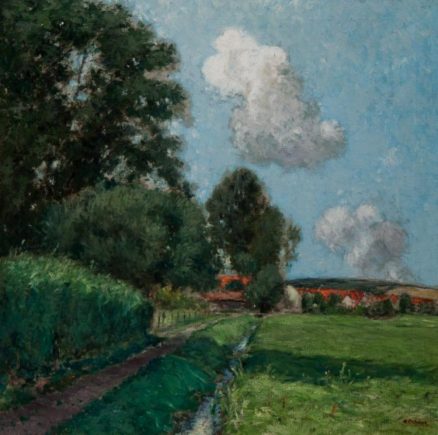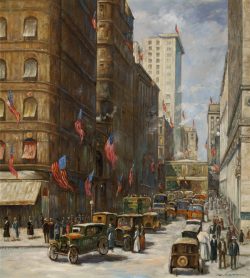- Categories
- Landscapes
- Zoom in on Artwork
- Print Page
- Email Page to Friend
Dividing a swath of trees and tall grasses from an open field, a country lane leads toward clustered low buildings in William Clusmann’s pastoral landscape. The composition is a play of subtle contrasts, from the balanced horizontal and vertical elements within the exactly square canvas to the juxtaposition of the red of the distant roofs with the cool blues and greens of sky, ground, and foliage. The deserted scene’s long shadows and the fair-weather sky, whose puffy clouds mimic the trees’ rounded forms, evoke a mood of contentment, while the scene’s fresh colors and the puddles on the rutted track testify to recent showers. In the manner of many fellow American impressionist painters portraying rural settings at the turn of the twentieth century, Clusmann in this image celebrates the peaceful agrarian landscape while showing none of its less glamorous reality.
Called Edge of the Village, this painting is assumed to be identical with a work of that title exhibited in the Art Institute of Chicago’s annual Chicago artists’ exhibition of 1912. It was one of two paintings singled out by the Chicago Tribune’s progressive critic Harriet Monroe as demonstrating Clusmann’s “newly developed strength.”i By that time, the artist had made a name for himself with his ambitious tonalist paintings of the smoky Chicago River. In Edge of the Village, however, Clusmann used a brighter palette influenced by impressionism, thus anticipating the sunny Chicago park scenes he would create later in the decade.
The red roofs in the background of this landscape composition point to a European subject. Clusmann studied in Germany in the early 1880s and may have returned to Europe around 1900–1901; in the following years landscape oils and watercolors with titles indicating European settings were occasionally among the works he showed in the Art Institute’s annual exhibitions. In 1918, when he had a well-reviewed solo show at Chicago’s Marshall Field and Company department store, Clusmann had “spent the last few years in painting abroad.”ii Edge of the Village may be a product of that stay. Yet apart from the red-roofed cottages, the setting might easily be one of those the artist more often found locally—as for example in the Fox River Valley. Indeed, like Clusmann’s 1917 Old Stone Bridge, Garfield Park (formerly Powell and Barbara Bridges Collection), a Chicago park view featuring similarly alien red-roofed cottages in the background, this landscape may be a composite of imagery drawn from both near-at-hand and distant settings.
Wendy Greenhouse, PhD
Donated by M. Christine Schwartz to Lake Forest College, Lake Forest, Illinois, in 2021
i Harriet Monroe, “Sterner Exhibit at Reinhardt’s Shows Large Variety of Medium,” Chicago Tribune, Feb. 11, 1912.
ii “Exhibitions at Chicago Galleries,” Fine Arts Journal 36 (April 1918): 39.

